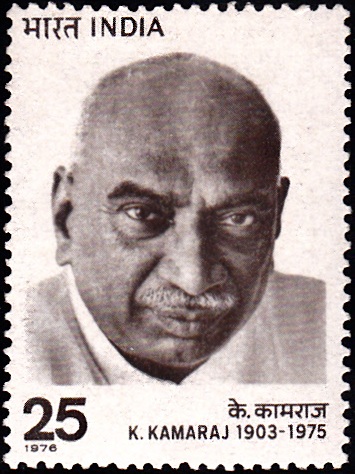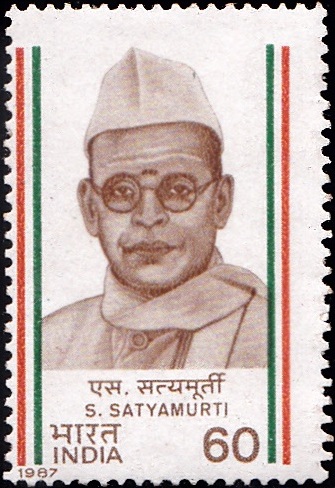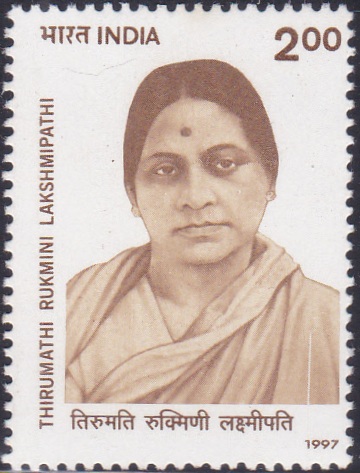
K. Kamaraj
A commemorative postage stamp on Kingmaker Kumaraswami Kamarajar, 3rd Chief Minister of Madras State (1954-63) and President of Indian National Congress (1964-67) :
Issued on Jul 15, 1976
Issued for : The Posts & Telegraphs Department feels privileged to bring out a commemorative postage stamp in honour of this distinguished freedom fighter and leader.
Photo by : Shri Harry Miller
Type : Stamp, Mint Condition
Colour : Suede gray
Denomination : 25 Paisa
Overall Size : 3.91 x 2.90 cms.
Printing Size : 3.56 x 2.54 cms.
Perforation : 13 x 13
Watermark : Printed on unwatermarked adhesive stamp paper
Number Printed : 30,00,000
Number per issue Sheet : 35
Printing process : Photogravure
Designed and printed at : India Security Press
Name : Kumaraswami Kamaraj
Born on Jul 15, 1903 at Virudhunagar, Tamil Nadu, India
Died on Oct 2, 1975 at Chennai, Tamil Nadu, India
About :
- Kumaraswamy Kamaraj belongs to the galaxy of selfless, dedicated and intrepid freedom fighters whose sacrifice and service won us independence from alien rule.
- Kamaraj was born on July 15, 1903 in a trading family of Virudhunagar, Ramanathapuram District in Tamil Nadu. He had his early education in the Nadar Vidyalaya High School at Virudhunagar and left the school at the age of eleven to assist in his uncle’s cloth shop. His inquisitiveness for understanding national affairs earned him a host of young friends who, infused with burning love for the country, tried to analyse in depth the social, economic and political plight of the nation. His interest in politics was accentuated when he heard of the ‘Jallianwala Bagh massacre’. Kamaraj participated in the famous Vaikom Satyagraha, and, following Mahatma Gandhi’s appeal for non-cooperation, he started propaganda for khadi and prohibition.
- Kamaraj was first jailed in 1921 for two years for participation in ‘Salt Satyagraha’. Thereafter, he had been to prison several times in the course of the national struggle for freedom. He was elected as Chairman of Virudhunagar Municipal Council while he was in jail and after release he took up the post for one day and resigned. He took an active part in individual satyagraha and the ‘Quit India’ movement.
- Kamaraj was elected to the Madras Legislative Assembly in 1932 unopposed. He was again elected to the Assembly in 1946 and served as Member of the Constituent Assembly of India, 1946. In 1957, he organised the historic Avadi Session of the Indian National Congress which adopted a resolution of far-reaching importance ushering in Democratic Socialism as a political concept. An able and arch organiser and dedicated worker, Kamaraj had great vision and the sterling quality of leadership which earned him the Presidentship of Tamil Nadu Congress Committee from 1940 to 1954.
- Kamaraj was elected to the Lok Sabha in 1951. He resigned his Lok Sabha membership when the mantle of Chief Ministership of Tamil Nadu fell on him in 1954. He continued in this post till 1963 when he voluntarily relinquished office under the ‘plan’ named after him to work for the party. During the period of his stewardship, the State made rapid strides of progress particularly in the field of education.
- Kamaraj had been a member of the Congress Working Committee or a special invitee from 1947. He was elevated to the high office of the President of the Indian National Congress in 1964 and held the post for two terms. He was a member of the Lok Sabha from 1969 till his death.
- As a strange and apt coincidence, Kamaraj, who was considered to be an ardent follower of Gandhiji, passed away in Madras on October 2, 1975, the anniversary of Mahatma Gandhi’s birthday. He was posthumously conferred “Bharat Ratna”, the highest national award in 1976.








[…] After resigning from the post of Chief Minister of Odisha he became the organizer of the Kamraj […]
[…] approach to problems. He made his ministerial debut in his home state in 1957 under the charismatic K. Kamaraj. In Tamil Nadu he came to be known as the ‘Father of Industrialization’ for taking that […]
[…] the then Madras State. He held various portfolios under two stalwart Chief Ministers, Rajaji and Kamaraj. As a Minister for Education, he laid a solid foundation for primary education. The main emphasis […]
[…] 1950, he came into contact with the Congress party stalwart Shri Kamaraj and became his staunch follower. Devoting himself fully to the activities of the Congress party, […]